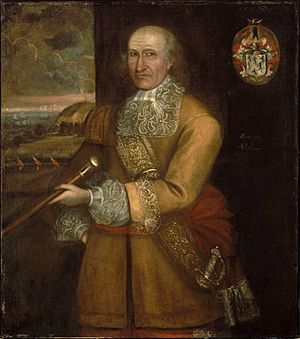Thomas Savage (major) facts for kids
Quick facts for kids
Thomas Savage
|
|
|---|---|

Major Thomas Savage, 1679, attributed to Thomas Smith
|
|
| Member of the Council of Assistants | |
| In office 1680–1682 |
|
| Speaker of the General Court | |
| In office 1677–1678 |
|
| In office 1671–1671 |
|
| In office 1660–1660 |
|
| In office 1637–1637 |
|
| Member of the General Court for Andover |
|
| In office 1672–1680 |
|
| Member of the General Court for Hingham |
|
| In office 1663–1671 |
|
| Member of the General Court for Boston |
|
| In office 1654–1662 |
|
| Personal details | |
| Born | 1608 Taunton, Somerset, England |
| Died | 14 February 1682 (aged 73) Boston, Massachusetts Bay Colony |
| Spouse | Faith Hutchinson |
| Signature | |
| Military service | |
| Rank | Major |
| Commands | Massachusetts Militia |
| Battles/wars | King Phillip's War |
Thomas Savage (born 1608, died 1682) was an important person in early American history. He was a soldier and a merchant in the first colonies of New England. He became a high-ranking officer, a Major, during a big conflict called King Philip's War.
Contents
Early Life and Moving to America
Thomas Savage was born in 1608 in a town called Taunton in Somerset, England. His father, William Savage, worked as a blacksmith. When Thomas was young, he started training with a group called the Merchant Taylors Company in London. This was like learning a trade to become a merchant.
In 1635, Thomas Savage traveled across the ocean to Massachusetts. He came on a ship called the Planter with another important person, Sir Henry Vane. In 1636, he became a "freeman" in Boston. This meant he had the right to vote and own land.
A New Start in Rhode Island
The next year, Thomas Savage supported his mother-in-law, Anne Hutchinson. She was a religious leader whose ideas caused some disagreements in the colony. Because of this, Thomas Savage had to leave Massachusetts.
In 1638, he joined William Coddington and others to start a new settlement. This new place was in what is now Rhode Island. Thomas Savage even signed an important agreement called the Portsmouth Compact. After living there for a while, he was allowed to return to Boston.
Military Service
Thomas Savage was very involved in the military of the colony. In 1637, he joined the Ancient and Honorable Artillery Company of Massachusetts. This was a special military group.
He quickly moved up in rank. In 1639, he became the company's second sergeant. The next year, he became the first sergeant. In 1641, he was chosen to be a lieutenant for one year.
He was elected as lieutenant again in 1645. Later, he became the captain of the company in 1651. He was re-elected as captain several times. He was likely the only person to be chosen as captain five times.
Thomas Savage also served in the colonial militia during King Philip's War. This was a major conflict between the colonists and Native American tribes.
Political Career
Thomas Savage was also a very active politician. In 1654, he was chosen to represent Boston in the "general court." This was like the colony's government or parliament. He continued to be a member for many years.
He was elected as the "speaker" of the assembly several times. This means he led the meetings of the general court. He was speaker in 1637, 1660, 1671, 1677, and 1678.
After representing Boston, he became a representative for Hingham in 1663. In 1664, he and other leaders disagreed with the colony's choice. The colony did not want to recognize four special representatives sent by King Charles II of England.
In 1671, he became a representative for Andover. In 1675, he led the colony's forces in the first major fight against Metacomet, a Native American leader.
In 1680, he was chosen to be an "assistant" or magistrate. This was a high-ranking official who helped govern the colony. He held this important job until he passed away on February 14, 1682.
Family Life
Thomas Savage was married two times. His first wife was Faith Hutchinson. They married in 1637. Faith was the daughter of William and Anne Hutchinson. Thomas and Faith had three sons and two daughters. Faith passed away in 1652.
On September 15, 1652, Thomas married his second wife, Mary Symmes. She was the daughter of Reverend Zechariah Symmes. Thomas and Mary had eight sons and three daughters. Mary lived longer than Thomas. After he died, she married Anthony Stoddard.

